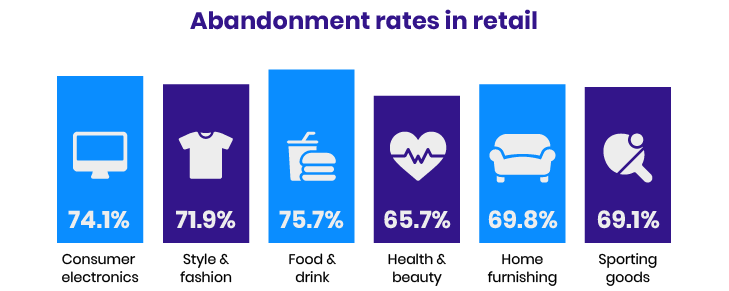-
Product Management
Software Testing
Technology Consulting
-
Multi-Vendor Marketplace
Online StoreCreate an online store with unique design and features at minimal cost using our MarketAge solutionCustom MarketplaceGet a unique, scalable, and cost-effective online marketplace with minimum time to marketTelemedicine SoftwareGet a cost-efficient, HIPAA-compliant telemedicine solution tailored to your facility's requirementsChat AppGet a customizable chat solution to connect users across multiple apps and platformsCustom Booking SystemImprove your business operations and expand to new markets with our appointment booking solutionVideo ConferencingAdjust our video conferencing solution for your business needsFor EnterpriseScale, automate, and improve business processes in your enterprise with our custom software solutionsFor StartupsTurn your startup ideas into viable, value-driven, and commercially successful software solutions -
-
- Case Studies
- Blog
Top 6 Ecommerce Metrics Every Online Store Should Track
Do you know how the most successful ecommerce businesses make win-win decisions? They track actionable metrics to know the current state of their business. Since they see the performance of their stores in real time, they know which business levers should be pushed and pulled to grow and be successful. But which metrics are really important? And how can you understand if they show trustworthy insights that will help you grow your business? Keep reading for answers to these questions and more.
Classifying ecommerce metrics
There are two main types of metrics for ecommerce businesses: vanity metrics and actionable metrics. Vanity metrics are deceptive. They make entrepreneurs feel good, but they don’t help them make meaningful business decisions. For example, say the number of monthly visitors to your website hits 20,000. Does this number give you any useful insights into what actions led to this growth or what to do next? In most cases, data on the number of visitors doesn’t help in making decisions to develop a business.
Actionable metrics are the second type. They’re focused on business outcomes and help you come up with valuable solutions. Let’s consider the following example. Imagine you’ve expanded your website by adding new features and you’ve decided to conduct A/B tests in which 50 percent of visitors see these features. After comparing the conversion rate for the set of customers who saw the new features with the conversion rate for those who didn’t, you see a 30 percent increase. This metric is actionable since it helps you make further decisions. For example, now you know that the new features satisfy users, and you can roll them out safely or test even more new options. Below, you can find a comparison of these two types of metrics and learn how to differentiate them.

How to identify good actionable metrics
A good metric can be compared across time periods. If you can compare a metric across different periods, it’s a good metric. It shows you progress or regress of your business and helps you understand what to do. Comparative metrics show you whether your decisions are moving you toward your business objectives.
A good metric is a ratio or a rate. Rates and ratios can be easily compared. For instance, you can see if you’re experiencing a sudden spike in the numbers or a trend by comparing the same metric over a number of months. Unlike absolute numbers, rates and ratios show change over time and give insights that are easier to act on.
The most important ecommerce metrics to track
Conversion rate
To put it simply, your conversion rate is the number of visitors who do what you want them to do. In ecommerce, it’s the percentage of customers who make a purchase on your website. To calculate your website’s conversion rate, divide the number of conversions in a period by the total number of visitors over that period and multiply the result by 100 percent.

For example, if your website had 51,232 unique visitors over the last three months and 10,117 conversions, your conversion rate is 19.7 percent. There are also useful advertising tools (AdWords) and analytics tools (Google Analytics) that can calculate your conversion rate automatically.
By tracking your conversion rate, you can measure the performance of your website. Knowing the number of visitors who complete a purchase is an actionable metric since you can use it to identify areas to improve your business and grow sales. When you know your conversion rate, you can proceed with conversion rate optimization (CRO). This is the process of generating hypotheses about why customers don’t convert and how to make them purchase from your website.
Customer lifetime value (CLV)
The second actionable metric ecommerce businesses should track is the lifetime value of every customer. This metric allows you to measure the total revenue a business brings in from a customer over the course of their relationship. CLV is an important metric because it shows the upper limit you can reasonably spend to acquire a new customer. It also encourages businesses to shift from focusing on short-term relationships with customers to long-term relationships. You can calculate your CLV using the following formula:

Customer lifetime value allows businesses to:
- manage customer relationships
- set the optimal amount of investment in marketing and user acquisition
- measure customer loyalty
- choose the right strategies to empower customer relationships
- monitor how marketing strategies and investments impact the value of customer assets
Customer acquisition cost
One more important metric worth paying attention to is customer acquisition cost (CAC). It shows the cost of advertising and marketing strategies aimed at getting a potential customer to buy your product or service. This metric can be calculated by simply dividing the total cost of acquiring new customers by the total number of new customers.

СAC is important to track since it helps you calculate the return on investment (ROI) of acquiring a customer. It’s important for a business to know each customer’s value so they know how many resources they should spend on the customer so as to be profitable.
Note that to make your ecommerce business profitable, your customer acquisition cost should be lower than the customer lifetime value.
Cart abandonment rate
According to SaleCycle, the average cart abandonment rate in the retail industry in 2018 was about 76 percent. This metric is important since it shows the number of shoppers who put an item in a shopping cart but don’t complete a purchase. In ecommerce, the cart abandonment rate varies by niche:

To calculate this metric for your ecommerce website, use this formula:

The reasons for a high cart abandonment rate can be many, so we can’t say how to lower it quickly. However, these tips can probably help your ecommerce business reduce cart abandonment:
- Make the checkout process simple and clear.
- Remind your customers they have items in the shopping cart. Send them cart abandonment emails to encourage them to come back and complete the purchase.
- Remarket your website to make your customers more engaged.
Average order value
Average order value (AOV) tracks the average revenue an ecommerce business gets from a purchase. To calculate your AOV, simply divide the total revenue by the number of orders you get over a period of time.

If you measure this metric but don’t know how to drive it up, here are some tips:
- Offer a product bundle. Combine several products into one bundle so customers can get everything in one click.
- Set a free shipping threshold. For example, offer free shipping at $50 to encourage users to spend more.
- Offer your customers additional features or premium products.
- Recommend products that can complement purchases.
Revenue by traffic source
There are different sources that bring traffic and potential customers to your website. The most important thing is that these traffic sources aren’t equal. Some of them bring more valid leads (visitors that are more likely to become customers), while other sources bring fewer. To run a successful business, you need to define which sources work best for you and stop investing in those that don’t. To know which traffic sources to invest in, calculate the revenue for each source.
To sum up
Any ecommerce store, small or big, should pay attention to actionable metrics. Tracking the right metrics can show your strong and weak points and give insights on how to improve website performance.
Subscribe to our newsletter for even more useful insights about ecommerce!










